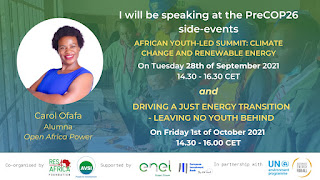Inclusion of women and youth in climate change mitigation and a just energy transition can be maximized ultimately by implementing the following recommendations:
1. Integration of women and youth in Grid connection, off-grid and renewable energy projects
- Opportunities in the energy sector can be used to better integrate women and youth within off-grid energy companies’ operations as well as the general supply chain.
- Throughout the world, a growing number of companies are leveraging this business opportunity by designing, producing, selling, and distributing off-grid energy technologies – which span solar lights, solar home systems, mini-grids, and clean cooking solutions (including fuels and cookstoves). Companies in the off-grid energy sector have much to gain through taking a purposeful gender and diversity lens throughout their operations and supply chains.
2. Affordable and inclusive Business models
- Innovative technologies geared towards climate change mitigation should be based on business models that focus on integrating a gender and diversity lens in design and research & development (R&D). This ensures that the needs of women and youth who form a majority of consumers within these markets, are taken into consideration when designing products and services. This can ultimately increase sales, adoption, and customer satisfaction.
3. Social inclusion: Women as change drivers
- In order to use social inclusion to increase awareness for climate change and promote energy transition we need to first understand and acknowledge unconscious social biases, implicit associations and change our mind sets on who can contribute to the issue of climate change and energy transition.
- Increase women's job opportunities, to fight pre-existing energy poverty, to build and support a more inclusive social and economic model by integrating policy that ensures a wider involvement of women and youth in the energy sector.
- Increase climate change awareness and promote Energy Transition by leveraging unique perspectives and experiences of women and youth.
4. Renewable energy education for the energy poor
- Renewable energy plays a crucial role due its ability to operate remotely and independently from the grid. Most preferable energy sources in remote communities tend to be solar, wind and biomass briquettes, all excellent mediums of reducing CO2 in the atmosphere. Communication and providing this education through the most viable and relevant avenues to make the role of women fashionable in the just energy transition.
- In most communities’ women still rely on wood, coal, charcoal, or animal waste for cooking and heating. Providing the necessary education as well as inclusion of women from marginalised communities in exploring contextually viable solutions that embrace green technologies means that clean cooking can be achieved.
5. Food security through adaptation to changes in weather patterns
- Climate change has shown its ability to disrupt food security. Changes in precipitation patterns, increased temperatures, unprecedented extreme weather events, reduced water availability, and not forgetting the recent locust invasion has resulted in reduced agricultural productivity, changes in food availability and food quality. Innovations within food security within the Agri-tech industry should consider the needs of those most affected by food insecurity.
Other notable recommendations
- Social inclusion by leveraging on unique perspectives and experiences to promote the energy transition
- Community engagement by ensuring active participation of women and youth in policy implementation as well as policy development.
- Communication through different avenues to make the role of women fashionable in the just energy transition. Companies should make advertisements that are climate change conscious that are relevant and spearheaded by women and youth.
- Use the covid 19 experience to understand the importance of having long lasting solutions that anticipate natural disasters.
- Abolish “The business-as-usual mentality” and hold industry leaders accountable at all levels
- Use of renewables for climate change mitigation should be adopted at individual, and companies’ level also at national levels.
I’ll be attending the COP-26 event being held in Glasgow to present these recommendations. I’d be more than glad to represent the women and youth in the energy sector in the quest to increase inclusion in the energy transition.

Comments
Post a Comment